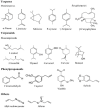Essential Oils: Sources of Antimicrobials and Food Preservatives
- PMID: 28138324
- PMCID: PMC5238431
- DOI: 10.3389/fmicb.2016.02161
Essential Oils: Sources of Antimicrobials and Food Preservatives
Abstract
Aromatic and medicinal plants produce essential oils in the form of secondary metabolites. These essential oils can be used in diverse applications in food, perfume, and cosmetic industries. The use of essential oils as antimicrobials and food preservative agents is of concern because of several reported side effects of synthetic oils. Essential oils have the potential to be used as a food preservative for cereals, grains, pulses, fruits, and vegetables. In this review, we briefly describe the results in relevant literature and summarize the uses of essential oils with special emphasis on their antibacterial, bactericidal, antifungal, fungicidal, and food preservative properties. Essential oils have pronounced antimicrobial and food preservative properties because they consist of a variety of active constituents (e.g., terpenes, terpenoids, carotenoids, coumarins, curcumins) that have great significance in the food industry. Thus, the various properties of essential oils offer the possibility of using natural, safe, eco-friendly, cost-effective, renewable, and easily biodegradable antimicrobials for food commodity preservation in the near future.
Keywords: antibacterial; antifungal; bioactivity; essential oils; food preservative properties.
Figures
References
-
- Abdollahi A., Hassani A., Ghosta Y., Bernousi I., Meshkatalsadat M. H. (2010). Study on the potential use of essential oils for decay control and quality preservation of Tabarzeh table grapes. J. Plant Prot. Res. 50, 45–52. 10.2478/v10045-010-0008-2 - DOI
-
- Agrios G. N. (2005). Plant Pathology, 5th Edn. Oxford: Elsevier Academic Press.
-
- Anthony S., Abeywickrama K., Wijeratnam S. W. (2003). The effect of spraying essential oils Cymbopogon nardus, C. flexuosus and Ocimum basilicum on post-harvest diseases and storage life of Embul banana. J. Hort. Sci. Biotech. 78, 780–785. 10.1080/14620316.2003.11511699 - DOI
-
- Arora R., Pandey G. N. (1977). The application of essential oils and their isolates for blue mould decay control in Citrus reticulata. J. Food Sci. Technol. 14, 14–16.
Publication types
LinkOut - more resources
Full Text Sources
Other Literature Sources



